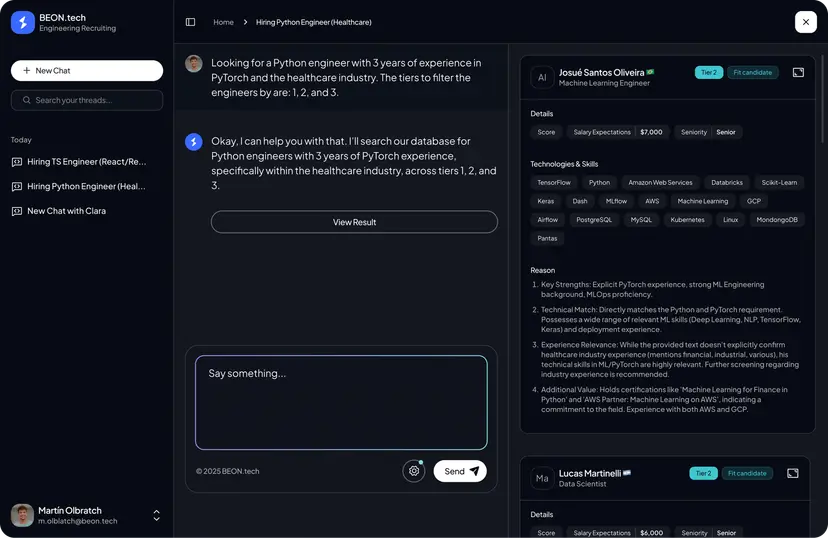
The promise of agentive AI lies in its ability to reduce cognitive load, streamline workflows, and enable teams to focus on high-impact work. From writing code and triaging support tickets to analyzing employee engagement or personalizing customer outreach, AI agent tools are beginning to play a central role in the modern tech stack.
But integrating AI agents isn’t just about automation, it’s about rethinking how work gets done. In this post, we’ll explore how AI agents are enhancing business operations, offer real-world AI agent examples and use cases, and share strategies for effectively integrating them into your workplace.
What Is Agentive AI?
Agentive AI refers to a new class of artificial intelligence systems that go beyond passive data analysis or rule-based automation. Unlike traditional AI models that require explicit prompts or narrow input, AI agents can adapt to dynamic environments.
According to McKinsey, agents are the “next frontier” of generative AI. They’re capable of performing multi-step tasks, continuously learning, and even orchestrating other tools or agents. This allows them to function not just as assistants, but as collaborators within your organization.
In practical terms, an AI agent might independently:
- Draft product documentation based on engineering updates
- Manage recruitment workflows
- Proactively monitor code quality to flag potential issues
What sets agentive AI apart is its capacity to operate within a broader decision-making loop. This means agents don’t just complete tasks…
- They can handle complexity and unpredictability. Traditional rule-based systems work well for linear processes with clearly defined steps, but they often fail when unexpected variables arise. In contrast, agents built on agentive AI can adapt in real-time, managing diverse outcomes and adjusting to evolving scenarios without breaking down.
- They’re programmable using natural language. Instead of translating workflows into code—a time-consuming and technically demanding task—agentic AI systems can be guided using simple language prompts. This reduces development overhead and empowers non-technical employees to participate in the automation process, making collaboration easier across teams.
- AI agents integrate seamlessly with existing digital tools. They can access and use software applications, search the web, gather feedback, and even coordinate with other models. This flexibility reduces the need for complex manual integrations and enables agents to act dynamically across systems. Something that would otherwise require significant engineering effort.
In other words, they operate according to goals, make choices, and adjust their actions based on outcomes. For tech companies, that opens the door to radically improving speed, accuracy, and scale across engineering, HR, marketing, and operations.
By adopting an agentic AI leadership mindset, companies can move beyond simply using AI to support employees and instead design systems where AI agents partner with them. This evolution marks a shift from AI-enhanced productivity to AI-powered collaboration—one that is already redefining what high-performance teams look like.
How AI Agents Work: A Closer Look at the Agentic Process
Understanding how AI agents for business operate is essential for leaders looking to integrate them into complex workflows. Unlike traditional automation tools that follow rigid scripts, agentive AI systems are dynamic, goal-oriented, and capable of intricate tasks by simulating collaborative problem-solving.
At a high level, here’s how generative AI-powered agents would typically function:
1. Natural Language Prompts Initiate the Workflow
It all starts with a simple instruction. A user gives a prompt, which is similar to giving instructions to a reliable team member. The system interprets this instruction, identifies the task, and, if necessary, asks clarifying questions to ensure it understands the user’s intent.
2. Agents Break Down and Delegate Work
The system then plans the workflow. Acting like a manager, the main agent breaks the task into smaller subtasks and assigns them to specialized subagents. These subagents bring domain-specific knowledge and use internal tools, databases, and contextual information to complete their portions of the task. Coordination happens dynamically, like team members collaborating on a project.
3. Iterative Refinement Ensures Precision
Throughout the process, the agent system may request feedback from the user to refine the outcome. Each cycle allows the system to adjust its approach, clarify ambiguities, and improve accuracy, creating a tight feedback loop between human input and machine output.
4. Final Execution and Delivery
Once the work is complete and validated, the agent executes the necessary action—whether that’s generating a report, sending an email, updating a dashboard, or completing a task in an external system. The goal is full task resolution, not just a static response.
Real-World AI Agent Use Cases Across Tech Departments
Tech companies across the globe are already deploying AI solutions and are becoming more interested in agentive AI to streamline operations, reduce costs, and accelerate decision-making. Let’s break down some of the most impactful AI agent use cases in today’s tech ecosystem:
1. Human Resources:
AI agents are streamlining HR operations by handling high-volume but critical tasks. Imagine an agent that sends personalized onboarding packages, schedules interviews based on candidate and interviewer availability, or automatically generates learning plans based on employee performance data.
A standout example is Clara, an AI Recruiter that automates interviews, evaluates candidates, and speeds up talent acquisition efficiently.
Powered by BEON.tech, Clara matches your job description with millions of vetted, world-class tech professionals across the globe. But she doesn’t stop there — Clara autonomously reaches out, detects interest, answers candidate questions, and keeps you updated in real time.
With AI-powered technical and cultural vetting tailored to your role, time zone, and way of working, Clara eliminates manual back-and-forth and brings the best candidates straight to you.

This is not just automation — it’s a smarter, faster, and radically more efficient way to hire.
2. Supply Chain
In supply chain management, AI agents can continuously analyze internal and external data to anticipate demand spikes, adjust inventory levels in real-time, and trigger reordering processes autonomously. By acting on signals from logistics systems, market trends, and even weather forecasts, agents ensure supply chains are responsive and resilient. The result: reduced waste, faster response times, and measurable cost savings.
3. Customer Service
AI agents can power sophisticated customer support systems that go beyond chatbots. These agents don’t just answer FAQs—they act on requests, escalate issues intelligently, and personalize interactions by drawing from CRM data and past interactions.
While human agents focus on complex, emotionally sensitive cases, AI agents handle the bulk of routine queries, reducing response times and enhancing customer satisfaction with 24/7 availability.
4. Finance
In finance, AI agents enhance planning and analysis by automatically surfacing key trends, running predictive models, and generating actionable insights. They can even set up rule-based financial processes, handle exceptions, and route approvals—all while maintaining transparency and traceability.
5. Software Development
Modernizing legacy systems is one of the most resource-draining initiatives for large tech organizations. But agentic AI leaders are beginning to rely on AI agents to accelerate this process. For example, an agent trained in legacy systems can scan massive codebases, document the business logic, and propose updates in modern programming languages.
Simultaneously, QA agents can review this code, write test cases, and flag inconsistencies. As these agents refine outputs iteratively, organizations create a repeatable and scalable system for future migrations—significantly reducing both technical debt and engineering costs.
6. Marketing
Designing and launching an online marketing campaign typically involves juggling multiple tools and touchpoints—ideation, copywriting, design, targeting, testing, and analytics. AI agents can unify this fragmented workflow.
Marketers provide inputs in natural language, outlining their target audience, tone, and objectives. Then, a network of agents—specialized in content creation, A/B testing, and performance analysis—generates and refines campaign assets in collaboration with human stakeholders.
By integrating platforms like CRMs, ad networks, and analytics tools, these agents help teams launch smarter campaigns faster, backed by real-time data and cross-functional coordination.
Strategic Considerations for Implementing AI Agents: Why the Right Talent Matters
Integrating AI agents for business isn’t as simple as plugging in a new tool. It requires rethinking technical infrastructure, reshaping workflows, and—most critically—building the right team. For organizations looking to adopt agentive AI at scale, one of the most important success factors is hiring engineers who understand the nuances of designing, deploying, and maintaining autonomous systems.
AI-Ready Teams Build Agent-Ready Systems
AI agents are far more complex than traditional software or even earlier generations of AI tools. They don’t just perform isolated tasks—they interact dynamically with data, tools, APIs, and people. This makes implementation inherently multidisciplinary. You’ll need engineers who are fluent in machine learning, prompt engineering, systems integration, and agent orchestration.
Building effective agents often involves creating a “control layer” that governs how they interface with business systems and each other. Without the right technical talent, organizations risk deploying agents that are either underpowered—or worse, misaligned with business goals.
Hiring engineers who specialize in agentive AI helps ensure your agents aren’t just technically functional, but strategically valuable. These professionals understand how to design feedback loops, define agent goals, fine-tune models, and implement safe, scalable systems that align with your company’s operations.
Think Beyond Tooling: Build a Culture of Experimentation
While there are many promising AI agent tools entering the market, even the best platforms won’t deliver results without a team capable of adapting them to your unique workflows. This is where AI engineering expertise comes into play—not just in implementation, but in ongoing iteration and refinement.
Successful AI adoption depends heavily on building trust and usability into the experience . Engineers who specialize in agentic AI can help design systems that are explainable, auditable, and easy for non-technical stakeholders to understand and work alongside.
Cross-Functional Collaboration Starts With the Right People
AI agents don’t exist in a vacuum. They must integrate across engineering, HR, finance, customer support, and more. That means your team must be able to collaborate cross-functionally—translating business needs into agent behaviors and vice versa.
Hiring engineers with a hybrid skill set—technical depth combined with product thinking—is essential. These are the people who will build the internal bridges between systems and stakeholders, making sure your AI agents for business are solving real problems, not creating new ones.
At BEON.tech, we’ve seen firsthand how companies that invest early in AI-fluent talent gain a significant competitive edge. Not just in faster deployment, but in the ability to build more adaptive, intelligent workflows that evolve with the business.
The Cost of Implementing Generative AI—And a Smarter Way to Scale
The promise of generative AI and agentive AI in the workplace is massive—but so is the cost of doing it right. For many companies, the barrier to entry isn’t just about technology—it’s about resources. Implementing AI agents for business requires a combination of cutting-edge infrastructure, highly specialized engineering talent, and a shift in how workflows are designed and maintained. It’s not a plug-and-play investment; it’s a strategic transformation.
The Hidden Costs Behind AI Agent Implementation
Building and integrating AI agents involves more than just licensing a tool or API. Companies must account for:
- Data engineering and model fine-tuning
- Toolchain integration with internal systems
- Security and compliance
- Cloud infrastructure and compute costs
- Ongoing iteration and optimization
And most importantly, you need developers who know what they’re doing—not just in building AI systems, but in scaling and adapting them over time. These specialists are in high demand and short supply, especially in major tech hubs like Silicon Valley, New York, or London.
Hiring this level of talent locally often comes with high overhead, long hiring cycles, and increasing competition. For many companies, this makes fully realizing the benefits of agentic AI feel out of reach.
Access Silicon Valley-Standard Talent—Without Silicon Valley Prices
Here’s where BEON.tech comes in. We help tech leaders tap into a vast, highly skilled pool of AI-fluent engineers from Latin America—professionals who have the experience, technical depth, and product mindset to build and maintain advanced AI agent tools.
These engineers operate at the same standard as top-tier U.S. talent, but at a fraction of the cost thanks to lower living expenses and advantageous currency exchange rates. With full time-zone alignment, cultural compatibility, and English fluency, LATAM developers can integrate seamlessly into your team and start delivering impact immediately.
This is more than just nearshoring—it’s a strategic way to build AI-powered systems efficiently, sustainably, and with the same level of excellence you’d expect from Silicon Valley teams.
So instead of stalling your AI roadmap due to budget constraints or local hiring bottlenecks, you can accelerate it by partnering with the right people, at the right price point. Let’s build your AI dev team together, schedule a call.
Michel decided to dedicate his life to the software industry at a very short age. He graduated with a degree in Computer Science and Mathematics. Since founding BEON, he and Damian have worked hard to establish it as an elite company, providing the best engineer LATAM talent to major U.S. companies.
Explore our
Is it Time to Cut Costs? How Nearshore AI Talent & Automation Can Help
As we move deeper into 2025, US businesses are navigating unprecedented economic headwinds. With inflation still looming, consumer spending contracting, and the very real threat of economic stagnation, engineering leaders and executives are being forced to make hard decisions. And in the world of software development, where top-tier engineering talent often comes with sky-high salaries…
How to Hire a Machine Learning Expert: The Full Guide for US Companies
Artificial intelligence (AI) is no longer a futuristic concept—it’s here, and it’s transforming industries quickly. From personalized recommendations in e-commerce to predictive analytics in healthcare, AI adoption is now essential. At the heart of this transformation lies machine learning (ML), which is key for companies leveraging data-driven strategies that can make the difference between leading…
Employer of Record (EOR) Services: Your Key to Hiring IT Talent Globally
The global tech industry is evolving rapidly, with companies increasingly looking beyond their local markets to find the best talent. Latin America has emerged as a prime destination for hiring skilled software developers due to its growing talent pool, cost advantages, and favorable time zones. However, expanding into new markets comes with challenges, particularly in…






